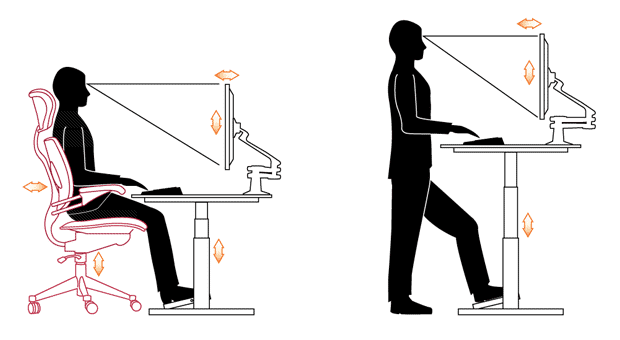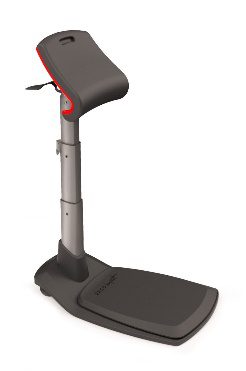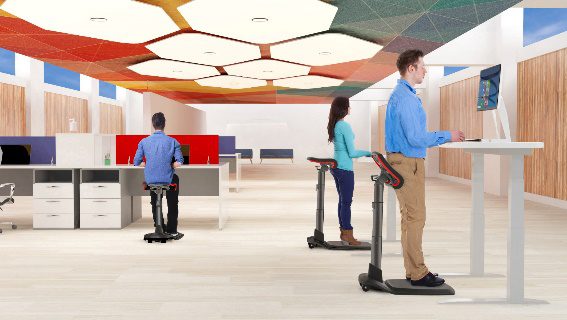Call Us Now1-800-414-2174


By Richard Bunch, PhD, PT, CBES and Trevor Bardarson, PT, OCS, CBES

The use of sit-stand stations has become an increasingly popular method for battling the effects of prolonged seated posture. However, the reality is that office workers, in general, prefer sitting over standing because it is less fatiguing than standing. As a result, you will generally notice that a person will start off using a sit-stand station correctly (the “Hawthorne effect”) and then eventually return to sitting the majority of the time. This standing avoidance behavior should be discouraged by education and administrative reinforcement on how to optimally use a sit-stand station if optimum results are desired.
First of all, let’s be clear on one major issue. Sit-stand chairs offer people only an ability to change from one static posture to another while working. This is good, but it does not, or I should say, should not, replace moving dynamically such as occurs when walking and performing dynamic posture relief and stretching exercises. Moving muscles and promoting circulation in the body are superior to simply making changes in static postures in terms of their effects on our health. Remember, humans are designed to move! The ideal situation then, is to maximize the benefits of a sit-stand stations while at the same time incorporating dynamic movement into your work day.
Sitting, a sedentary activity, results in very low energy expenditure, (burning less calories) than standing and as such increases the risk (along with poor nutrition) for becoming overweight and obese. Consequently, sitting increases the risk for developing type II diabetes and cardiovascular disease. Prolonged sitting, especially slumped sitting, also causes musculoskeletal disorders (MSDs) such as those involving the neck, the shoulders and the lower back. For example, sitting, especially slumped sitting, causes greater disc pressure in the lumbar spine than standing. Thus, you are more likely to rupture a lumbar disc from prolonged sitting as compared to prolonged standing.
Standing reduces excess stress on the lumbar discs caused by sitting, but has its own set of risk factors which are mainly musculoskeletal and vascular in nature. Although standing may burn more calories than sitting, when prolonged, it also causes stress on the lower back and feet. Unlike sitting, the stress on the lower back when standing is more related to the increased compression on the lumbar facet joints (as opposed to the discs) which occurs as the abdominal muscles relax and the pelvis tilts forward and downward. The forward downward tilt of the pelvis resulting from abdominal muscle relaxation during prolonged standing causes a compensatory increase in the lumbar lordosis (i.e, increase in the curve of the lumbar spine forward) which in turn causes an increased compression on lumbar facet joints. This can cause significant lower back pain. Prolonged standing also leads to flattening of the arches of the feet that can lead to plantar fasciitis and heel spurs. Prolonged standing can also cause pooling of blood in the legs/feet, venous varicosities, blood clots, and edema (swelling) in the legs/feet.
Therefore, in order to make a sit-stand station work, people must be motivated on how periodically standing benefits them and become disciplined to change the postures on a regular basis. The key is not to stay in any either posture (sitting or standing) too long. But how long is too long when we sit or stand? The answer is not as simple as it may seem because sitting and standing tolerance and the impact of these postures on health vary based primarily on three main factors:
As we age, the discs in our spine, especially in the lumbar spine, become narrower as they lose fluid over time. Also, as we become less physically fit, the abdominal muscles weaken and become distended due to excess belly fat. With age the fat pads in the soles of our feet atrophy (waste away) and the arches in our feet flatten. All of these changes collectively lead to earlier onset of low back and foot pain respectively with prolonged standing.
Our tolerance to prolonged standing also is further reduced by medical problems such as obesity, degenerative disc disease, foraminal stenosis, facet joint disease, plantar fasciitis, heel spurs, and sway back. In addition, women will have less tolerance to standing during pregnancy, especially during the third trimester. Tolerance to sitting can also be adversely affected by some of these conditions as well as herniated spinal discs.
Therefore, there is no set hard rule on how long a person should sit versus stand. However, the following guidelines are good starting points and can be modified in response to a person’s comfort level in each posture.
General Guidelines based on Age:
Less than 40 years of age: Sit 30 minutes and stand 30 minutes
Age 40 years and older: Sit 45 minutes and stand 15 minutes
Note: These time periods may need to be altered based on each person’s comfort level and the effects of any medical conditions as stipulated earlier.
Standing tolerance may be assisted by anti-fatigue matts and standing desk chairs such as the LeanRite™, (shown below). The LeanRite™ chair is fully adjustable from 23.3″ to 46.5″, allowing for sitting, leaning, perching and standing as one unit. (Note, the mention of this chair brand is provided as an example of a standing desk chair and does constitute an endorsement.)


Warning: If sit-stand stations are made available to office workers, without proper education of their benefit and the importance of changing postures, as well as without administrative reinforcement of actually using a sit-stand station to change postures, most office workers will over time gravitate to using sit-stands station only in the seated position and, at best, use it in the standing position only when there is significant discomfort experienced from sitting. Be advised that it is never a good idea to wait for pain to change postures. Pain can occur, especially if the pain is related to a spinal disc, well after tissue damage has occurred.
In addition to changing static seated and standing work postures, dynamic posture relief exercises to include periodic walking should also be strongly encouraged after sitting for more than 45 minutes at any one time. More frequent dynamic activity breaks are even better. There are rest break software programs available that can be programmed to notify the user at various time intervals of a need for a rest break. However, such software is often ignored by the employee if the importance of stretch breaks is not made clear as it relates to personal health.
So, Do Sit-Stand Stations Really Work?
Like any equipment designed to reduce injury and improve health, the answer is, “It depends”. The benefits of a sit-stand station are gained only when used intelligently. There is no set standard for everyone as each person’s body and health status varies. Changing posture is always a good thing. Sit-stand stations work depending on whether or not the person uses the sit-stand workstation to change postures from sitting to standing and vice versa on a regular basis and in a manner in which time is allotted for each posture as it relates to a person’s age, health status, and comfort tolerance.
For more questions about sit-stand stations or other ergonomic issues, please contact Dr. Bunch or Trevor Bardarson, PT, OCS, CBES at our WorkSaver office – (800) 414-2174.
Interested in becoming certified as a Behavioral-Based Ergonomic Specialist (CBES)?
The unique CBES credentialing program is used nationally by ergonomic specialists, safety and occupational health professionals and integrates wellness interventions with the latest concepts in office and field ergonomic assessments. Check out our CBES credentialing program at www.CBES-ergonomics.com . Soon to be offered online!
WorkSaver Employee Testing Systems 478 Corporate Dr. Houma, LA 70360
![]()